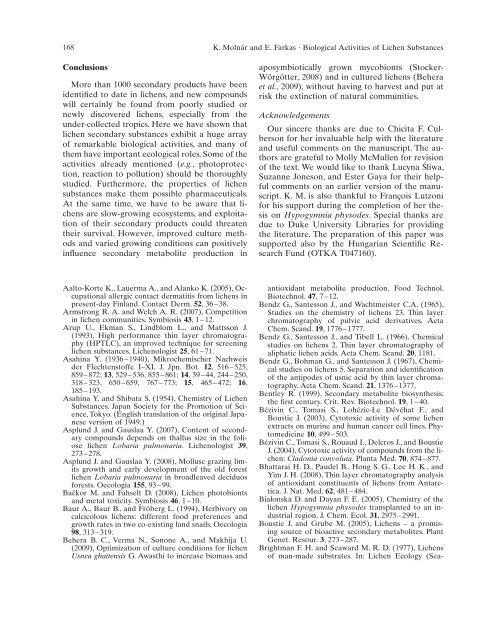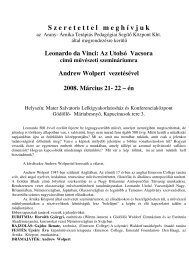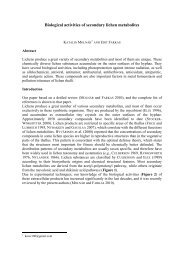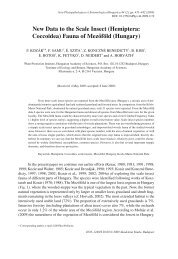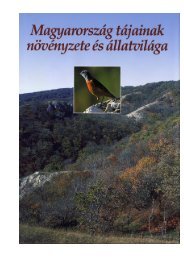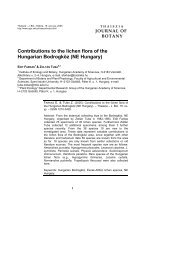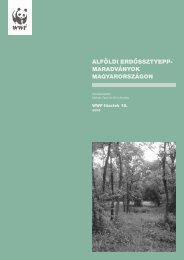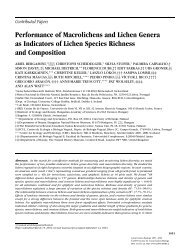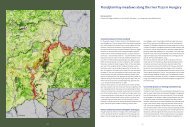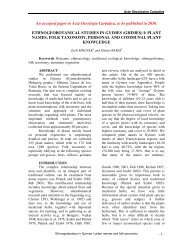Current Results on Biological Activities of Lichen ... - Lichens and Me
Current Results on Biological Activities of Lichen ... - Lichens and Me
Current Results on Biological Activities of Lichen ... - Lichens and Me
Create successful ePaper yourself
Turn your PDF publications into a flip-book with our unique Google optimized e-Paper software.
168 K. Molnár <strong>and</strong> E. Farkas · <strong>Biological</strong> <strong>Activities</strong> <strong>of</strong> <strong>Lichen</strong> Substances<br />
C<strong>on</strong>clusi<strong>on</strong>s<br />
More than 1000 sec<strong>on</strong>dary products have been<br />
identified to date in lichens, <strong>and</strong> new compounds<br />
will certainly be found from poorly studied or<br />
newly discovered lichens, especially from the<br />
under-collected tropics. Here we have shown that<br />
lichen sec<strong>on</strong>dary substances exhibit a huge array<br />
<strong>of</strong> remarkable biological activities, <strong>and</strong> many <strong>of</strong><br />
them have important ecological roles. Some <strong>of</strong> the<br />
activities already menti<strong>on</strong>ed (e.g., photoprotecti<strong>on</strong>,<br />
reacti<strong>on</strong> to polluti<strong>on</strong>) should be thoroughly<br />
studied. Furthermore, the properties <strong>of</strong> lichen<br />
substances make them possible pharmaceuticals.<br />
At the same time, we have to be aware that lichens<br />
are slow-growing ecosystems, <strong>and</strong> exploitati<strong>on</strong><br />
<strong>of</strong> their sec<strong>on</strong>dary products could threaten<br />
their survival. However, improved culture methods<br />
<strong>and</strong> varied growing c<strong>on</strong>diti<strong>on</strong>s can positively<br />
influence sec<strong>on</strong>dary metabolite producti<strong>on</strong> in<br />
aposymbiotically grown mycobi<strong>on</strong>ts (Stocker-<br />
Wörgötter, 2008) <strong>and</strong> in cultured lichens (Behera<br />
et al., 2009), without having to harvest <strong>and</strong> put at<br />
risk the extincti<strong>on</strong> <strong>of</strong> natural communities.<br />
Acknowledgements<br />
Our sincere thanks are due to Chicita F. Culbers<strong>on</strong><br />
for her invaluable help with the literature<br />
<strong>and</strong> useful comments <strong>on</strong> the manuscript. The authors<br />
are grateful to Molly McMullen for revisi<strong>on</strong><br />
<strong>of</strong> the text. We would like to thank Lucyna Śliwa,<br />
Suzanne J<strong>on</strong>es<strong>on</strong>, <strong>and</strong> Ester Gaya for their helpful<br />
comments <strong>on</strong> an earlier versi<strong>on</strong> <strong>of</strong> the manuscript.<br />
K. M. is also thankful to François Lutz<strong>on</strong>i<br />
for his support during the completi<strong>on</strong> <strong>of</strong> her thesis<br />
<strong>on</strong> Hypogymnia physodes. Special thanks are<br />
due to Duke University Libraries for providing<br />
the literature. The preparati<strong>on</strong> <strong>of</strong> this paper was<br />
supported also by the Hungarian Scientific Research<br />
Fund (OTKA T047160).<br />
Aalto-Korte K., Lauerma A., <strong>and</strong> Alanko K. (2005), Occupati<strong>on</strong>al<br />
allergic c<strong>on</strong>tact dermatitis from lichens in<br />
present-day Finl<strong>and</strong>. C<strong>on</strong>tact Derm. 52, 36 – 38.<br />
Armstr<strong>on</strong>g R. A. <strong>and</strong> Welch A. R. (2007), Competiti<strong>on</strong><br />
in lichen communities. Symbiosis 43, 1 – 12.<br />
Arup U., Ekman S., Lindblom L., <strong>and</strong> Mattss<strong>on</strong> J.<br />
(1993), High performance thin layer chromatography<br />
(HPTLC), an improved technique for screening<br />
lichen substances. <strong>Lichen</strong>ologist 25, 61 – 71.<br />
Asahina Y. (1936 – 1940), Mikrochemischer Nachweis<br />
der Flechtenst<strong>of</strong>fe I–XI. J. Jpn. Bot. 12, 516 – 525,<br />
859 – 872; 13, 529 – 536, 855 – 861; 14, 39 – 44, 244 – 250,<br />
318 – 323, 650 – 659, 767 – 773; 15, 465 – 472; 16,<br />
185 – 193.<br />
Asahina Y. <strong>and</strong> Shibata S. (1954), Chemistry <strong>of</strong> <strong>Lichen</strong><br />
Substances. Japan Society for the Promoti<strong>on</strong> <strong>of</strong> Science,<br />
Tokyo. (English translati<strong>on</strong> <strong>of</strong> the original Japanese<br />
versi<strong>on</strong> <strong>of</strong> 1949.)<br />
Asplund J. <strong>and</strong> Gauslaa Y. (2007), C<strong>on</strong>tent <strong>of</strong> sec<strong>on</strong>dary<br />
compounds depends <strong>on</strong> thallus size in the foliose<br />
lichen Lobaria pulm<strong>on</strong>aria. <strong>Lichen</strong>ologist 39,<br />
273 – 278.<br />
Asplund J. <strong>and</strong> Gauslaa Y. (2008), Mollusc grazing limits<br />
growth <strong>and</strong> early development <strong>of</strong> the old forest<br />
lichen Lobaria pulm<strong>on</strong>aria in broadleaved deciduos<br />
forests. Oecologia 155, 93 – 99.<br />
Bačkor M. <strong>and</strong> Fahselt D. (2008), <strong>Lichen</strong> photobi<strong>on</strong>ts<br />
<strong>and</strong> metal toxicity. Symbiosis 46, 1 – 10.<br />
Baur A., Baur B., <strong>and</strong> Fröberg L. (1994), Herbivory <strong>on</strong><br />
calcicolous lichens: different food preferences <strong>and</strong><br />
growth rates in two co-existing l<strong>and</strong> snails. Oecologia<br />
98, 313 – 319.<br />
Behera B. C., Verma N., S<strong>on</strong><strong>on</strong>e A., <strong>and</strong> Makhija U.<br />
(2009), Optimizati<strong>on</strong> <strong>of</strong> culture c<strong>on</strong>diti<strong>on</strong>s for lichen<br />
Usnea ghattensis G. Awasthi to increase biomass <strong>and</strong><br />
antioxidant metabolite producti<strong>on</strong>. Food Technol.<br />
Biotechnol. 47, 7 – 12.<br />
Bendz G., Santess<strong>on</strong> J., <strong>and</strong> Wachtmeister C.A. (1965),<br />
Studies <strong>on</strong> the chemistry <strong>of</strong> lichens 23. Thin layer<br />
chromatography <strong>of</strong> pulvic acid derivatives. Acta<br />
Chem. Sc<strong>and</strong>. 19, 1776 – 1777.<br />
Bendz G., Santess<strong>on</strong> J., <strong>and</strong> Tibell L. (1966), Chemical<br />
studies <strong>on</strong> lichens 2. Thin layer chromatography <strong>of</strong><br />
aliphatic lichen acids. Acta Chem. Sc<strong>and</strong>. 20, 1181.<br />
Bendz G., Bohman G., <strong>and</strong> Santess<strong>on</strong> J. (1967), Chemical<br />
studies <strong>on</strong> lichens 5. Separati<strong>on</strong> <strong>and</strong> identificati<strong>on</strong><br />
<strong>of</strong> the antipodes <strong>of</strong> usnic acid by thin layer chromatography.<br />
Acta Chem. Sc<strong>and</strong>. 21, 1376 – 1377.<br />
Bentley R. (1999), Sec<strong>on</strong>dary metabolite biosynthesis:<br />
the first century. Crit. Rev. Biotechnol. 19, 1 – 40.<br />
Bézivin C., Tomasi S., Lohézic-Le Dévéhat F., <strong>and</strong><br />
Boustie J. (2003), Cytotoxic activity <strong>of</strong> some lichen<br />
extracts <strong>on</strong> murine <strong>and</strong> human cancer cell lines. Phytomedicine<br />
10, 499 – 503.<br />
Bézivin C., Tomasi S., Rouaud I., Delcros J., <strong>and</strong> Boustie<br />
J. (2004), Cytotoxic activity <strong>of</strong> compounds from the lichen:<br />
Clad<strong>on</strong>ia c<strong>on</strong>voluta. Planta <strong>Me</strong>d. 70, 874 – 877.<br />
Bhattarai H. D., Paudel B., H<strong>on</strong>g S. G., Lee H. K., <strong>and</strong><br />
Yim J. H. (2008), Thin layer chromatography analysis<br />
<strong>of</strong> antioxidant c<strong>on</strong>stituents <strong>of</strong> lichens from Antarctica.<br />
J. Nat. <strong>Me</strong>d. 62, 481 – 484.<br />
Biał<strong>on</strong>ska D. <strong>and</strong> Dayan F. E. (2005), Chemistry <strong>of</strong> the<br />
lichen Hypogymnia physodes transplanted to an industrial<br />
regi<strong>on</strong>. J. Chem. Ecol. 31, 2975 – 2991.<br />
Boustie J. <strong>and</strong> Grube M. (2005), <strong>Lichen</strong>s – a promising<br />
source <strong>of</strong> bioactive sec<strong>on</strong>dary metabolites. Plant<br />
Genet. Resour. 3, 273 – 287.<br />
Brightman F. H. <strong>and</strong> Seaward M. R. D. (1977), <strong>Lichen</strong>s<br />
<strong>of</strong> man-made substrates. In: <strong>Lichen</strong> Ecology (Sea-


